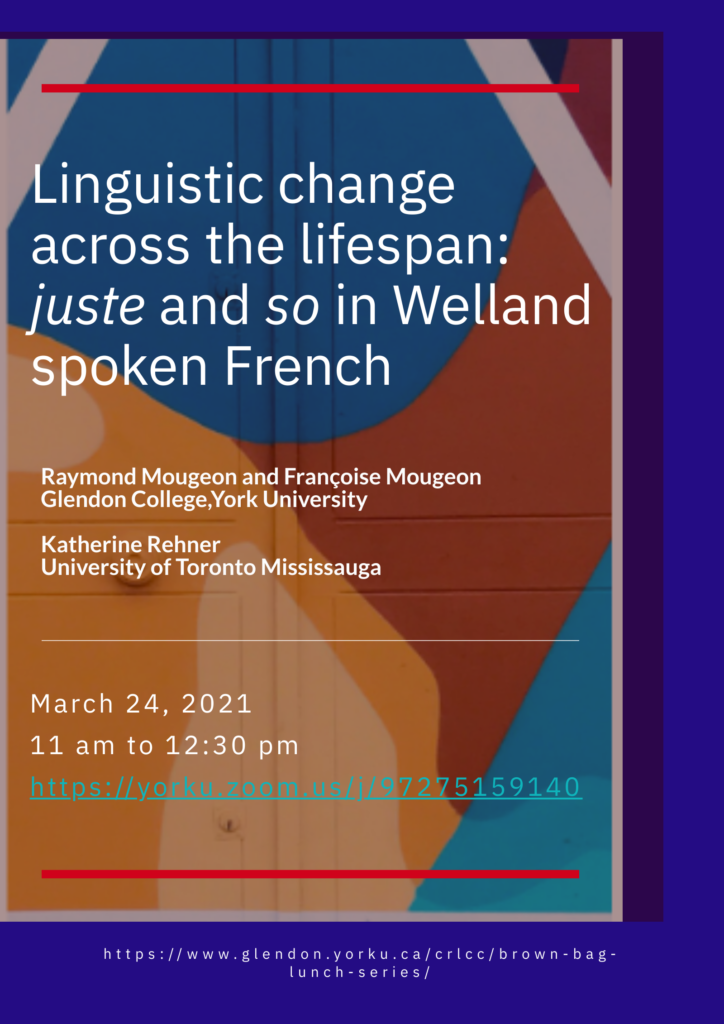Linguistic change across the lifespan: juste and so in Welland spoken French
Raymond Mougeon and Françoise Mougeon, Glendon College,York University
Katherine Rehner, University of Toronto Mississauga
https://yorku.zoom.us/j/97275159140
A common assumption is that grammatical or phonological change is driven by children and that speakers’ grammar or phonology remains stable after late adolescence (Sankoff, 2019). Consequently, it has also been assumed that adults are unlikely to participate in ongoing cases of phonological or grammatical change. While these assumptions have, until recently, remained largely unverified, a new research strand has begun to scrutinize this topic by focusing on cases of ongoing grammatical or phonological change by examining speech data from different points in adult speakers’ lives to verify if they are participating in the change. With respect to French, G. Sankoff and her associates have carried out this kind of research based on corpora collected in Montreal that include both panel speakers (individuals recorded twice, in 1971 and in 1984, or three times, in 1971, 1984 and 1995) who provide data on change across the lifespan and trend speakers (socially stratified speaker samples recorded once in 1971 or 1984) who are used to establish community-level patterns of variation and change. Such patterns constitue a useful backdrop in the analysis of the linguistic behavior of the panel speakers. These Montreal studies examined three cases of morphosyntactic change and one case of phonological change and found that the panel speakers participated in the case of ongoing phonological change and in one of the three cases of morphosyntactic change.
As part of a project investigating change in Montreal and in Welland spoken French from the 1970s to 2010s, the present study, focusing on Welland French, is akin to those of G. Sankoff. It examines change across the lifespan using a combination of panel and trend speakers, and it examines two cases of morphosyntactic change (the rise of restrictive adverb juste ‘only’ and of conjunction so ‘therefore’). However, it also has several distinctive features. First, since it examines change over a forty-year period (1975 to 2012-15), several of the panel speakers had retired one or two decades prior to the second recording, allowing us to capture patterns of change observable later in the speakers’ lives—an issue not documented in previous research. Second, while Montreal and Welland French are genetically-related varieties, French in Welland is a minority language experiencing much more intense contact with English, thus allowing us to consider the relative importance of these languages in the panel speakers’ educational and occupational histories and identity, as explanatory factors for interindividual similarities or differences in their (non-)participation in change. Third, while the cases of change examined in Montreal are driven by higher SES speakers, in Wellland, the rise of juste and of so are driven by lower SES speakers. Our study adduces evidence of individual participation in BOTH cases of change, though it shows a much higher proportion of panel speakers participating in the rise of juste than of so. In our discussion of factors accounting for these findings, we point out that while both juste and so have been favored by lower SES speakers, so, as a borrowing from English, has met with much stiffer resistance among higher SES speakers than juste, and hence so is a more stigmatized vernacular variant.
References
Sankoff, Gillian. 2019. Language change across the lifespan: three trajectory types, Language, (95), 2, 197-229.


